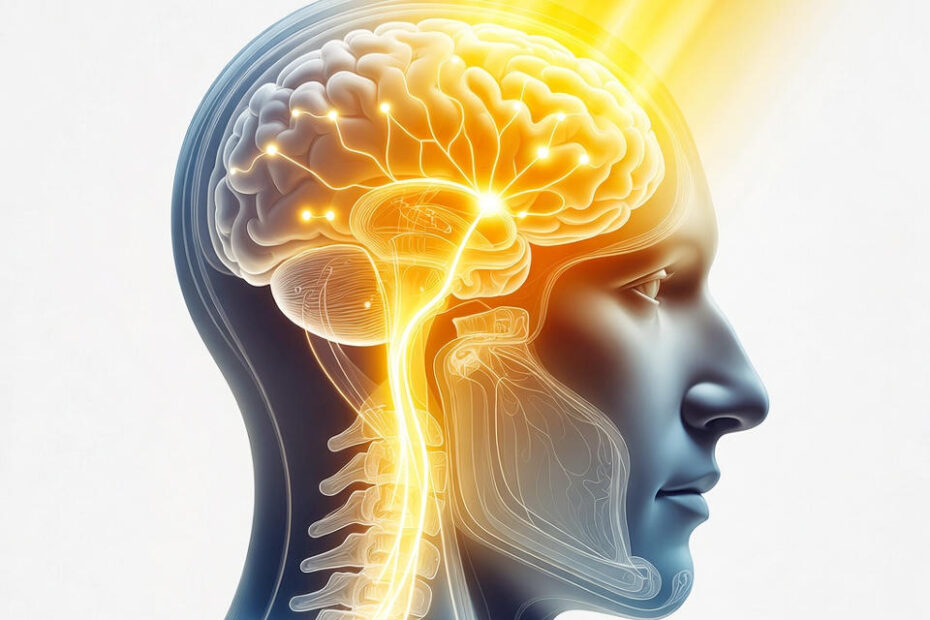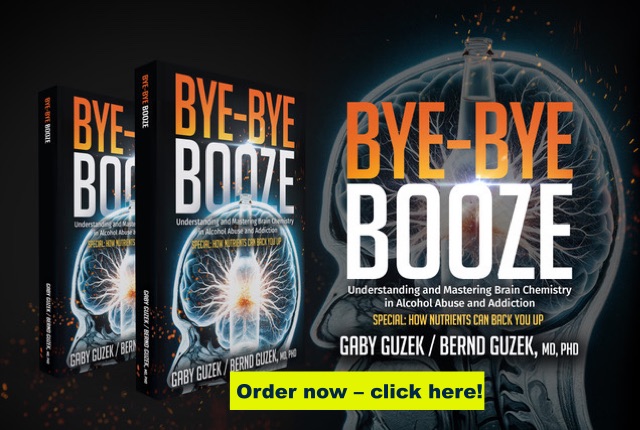Vitamin D – the “sunshine vitamin” – is best known for supporting bones, muscles, and the immune system. Yet emerging research suggests it also plays a critical role in the brain’s reward circuitry. A deficiency may heighten vulnerability to addiction, while adequate levels appear to promote emotional stability and resilience.
Bernd Guzek, MD, PhD
Growing Evidence: The Link Between Vitamin D Deficiency and Addiction
When most people think of vitamin D, they picture strong bones or fewer colds – not alcohol or drug addiction. Yet a growing body of research indicates that chronically low vitamin D levels can make the brain’s reward system more susceptible to addictive substances and behaviours.
Some researchers are now asking whether vitamin D might be a genuine “key vitamin” in the fight against addiction. The evidence is not yet conclusive, but it is mounting – and optimising vitamin D status is simple, safe, and inexpensive.
Vitamin D: Far More Than Just the Sunshine Vitamin
The body produces vitamin D when UVB rays strike the skin, converting a cholesterol precursor into cholecalciferol (vitamin D₃). The liver and kidneys then transform it into its active form, calcitriol – a powerful steroid hormone that influences over 2,000 genes.
Nearly every cell in the body, including neurons, possesses vitamin D receptors (VDRs). Beyond bone health, vitamin D modulates inflammation, protects cells, regulates hormones, and influences neurotransmitter synthesis – particularly dopamine, norepinephrine, and serotonin, the very chemicals that govern motivation, mood, and reward.
Rather than acting as a stimulant, vitamin D stabilises: it calms excessive neuronal firing while supporting neuroplasticity and repair. Adequate levels help maintain balanced stress responses and emotional regulation – precisely the systems that become dysregulated in addiction.
What Does Vitamin D Actually Do in the Brain?
Vitamin D receptors are abundant in the brain’s reward centres: the ventral tegmental area, nucleus accumbens, and prefrontal cortex. When activated, they fine-tune dopamine signalling, reduce neuroinflammation, and protect neurons from oxidative stress.
Low vitamin D appears to amplify craving and reduce impulse control. Genetic variations in the VDR can further weaken this protective effect, making certain individuals especially vulnerable when levels drop.
Chronic heavy drinking also triggers brain inflammation, which disrupts dopamine pathways. Vitamin D normally dampens this inflammatory response. Without it, the reward system remains in a heightened state of excitability – increasing the pull of alcohol or other drugs.
Many people experience this as restlessness, irritability, or feeling overwhelmed. Correcting vitamin D deficiency won’t eliminate addiction on its own, but it can significantly calm the neurological “noise” that makes abstinence harder.
Alcohol Dependence and Vitamin D Deficiency
People with alcohol use disorder almost always have lower vitamin D levels than the general population – in some studies, up to two-thirds are frankly deficient.
The reasons are multiple: alcohol impairs gut absorption and liver activation, heavy drinkers often avoid sunlight, nutrition is poor, and advanced liver disease (fatty liver or cirrhosis) traps vitamin D in fat tissue instead of releasing it into the bloodstream.
Low mood, fatigue, and muscle aches during withdrawal are frequently blamed solely on alcohol cessation – yet untreated vitamin D deficiency can dramatically worsen these symptoms and erode motivation to stay sober.
Opioid Dependence: A Similar Picture
Studies of patients on methadone or buprenorphine maintenance consistently show severe vitamin D deficiency – sometimes affecting nearly 100 % of participants, even in sunny countries.
Animal research reinforces the connection: vitamin D-deficient mice develop stronger preference for opioids and even for UV light (which triggers endogenous endorphin release). A small human trial giving high-dose vitamin D to methadone patients found significant improvements in mood and cognitive function within months.
Time for Routine Vitamin D Testing in Addiction Medicine
We don’t yet have large randomised trials proving that vitamin D supplementation directly prevents relapse. But the biological mechanisms are plausible, the deficiency is extremely common, and correction is low-risk and low-cost.
Measuring 25-hydroxyvitamin D should become standard practice in addiction treatment – not as a miracle cure, but as an important piece of the recovery puzzle.
How to Achieve and Maintain Healthy Vitamin D Levels
Most experts now consider 50–70 ng/ml (125–175 nmol/l) the optimal range for immune function, mood, and metabolic health. Traditional laboratory “normal” ranges (20–30 ng/ml) are increasingly viewed as insufficient.
Natural Sunlight
In Central Europe, meaningful vitamin D synthesis only occurs between April and September, around midday, when the sun is high enough. In winter, UVB rays simply don’t reach the ground in sufficient quantity – even on bright, cold days.
Dietary Sources
Food alone cannot supply adequate amounts for most people living north of the 35th parallel. You would need to eat 500–700 g of wild salmon or herring daily to reach 4,000 IU – clearly unrealistic.
Supplementation – The Practical Solution
Vitamin D₃ (cholecalciferol) in drops or capsules is highly effective. A rough guide:
- To raise levels by 40 ng/ml typically requires ~40,000 IU per week (≈ 5,000–6,000 IU/day) for several weeks.
- Maintenance: 2,000–5,000 IU daily for most adults.
- People with obesity, liver disease, or malabsorption often need higher doses.
Regular blood testing (late autumn and early spring) remains the safest way to personalise dosing.
Safety and Toxicity – Putting Concerns into Perspective
Vitamin D is fat-soluble and can accumulate, but toxicity is rare below 10,000 IU/day in healthy adults and almost never occurs at levels under 150 ng/ml when kidney function is normal.
Historical fears stem from extreme overdosing in the 1930s–1950s. Modern protocols (including high-dose approaches like the Coimbra Protocol) are used safely under medical supervision.
Bottom line: aiming for 50–70 ng/ml (125–175 nmol/l) is both effective and safe for the vast majority of people.
FAQ
Vitamin D cannot cure addiction on its own, but it powerfully supports the body and brain in stabilising the reward system. A deficiency clearly worsens mood swings, fatigue, and stress – all well-known triggers for relapse in alcohol or other addictions. Adequate vitamin D levels can therefore be a valuable building block in relapse prevention, though they never replace proper therapy.Can vitamin D cure alcohol addiction or other dependencies?
Leading international experts recommend serum levels of 50–70 ng/ml (125–175 nmol/l). Below 20 ng/ml is considered a clear deficiency; below 10 ng/ml there is a risk of muscle cramps or tetany. Levels above 150 ng/ml are potentially risky and should only occur under medical supervision. In the context of addiction, maintaining sufficient levels helps stabilise metabolism and nervous-system function.What are the optimal vitamin D blood levels for overall health and addiction prevention?
Depending on the starting level, it usually takes 8–12 weeks to reach a stable range. With a daily dose of 4,000–6,000 IU or two 20,000 IU capsules per week, levels rise reliably. After that, a maintenance dose of 2,000–4,000 IU per day is generally sufficient. A follow-up blood test after about 10 weeks shows whether the dosage is right.How quickly can a vitamin D deficiency be corrected?
In Central Europe, meaningful vitamin D synthesis only occurs from April to September when the sun is high enough around midday. In winter the UV-B rays hit the ground at too shallow an angle – even on a sunny ski slope. Sunlight through windows doesn’t help either. Anyone living north of Sicily (or roughly north of the 35th parallel) should rely on supplementation or medically supervised dosing during the winter months.Can I get enough vitamin D from sunlight – even in winter?
The most accurate method is a blood test for 25-hydroxyvitamin D (25-OH-D). Your GP or a laboratory can perform it; privately it costs around €25–35. The ideal times are late autumn (annual low point) and 8–12 weeks after starting supplementation. This prevents both persistent deficiency and accidental over-dosing.How do I test my vitamin D level and when does it make sense?
-
Putative role of vitamin D in the mechanism of alcoholism and other addictions – a hypothesis (2020/2021)
Hypothesis paper: Proposes that low vitamin D may influence dopaminergic reward circuits and discusses genetic variations of the vitamin D receptor (VDR).
PubMed · Cambridge -
Vitamin D deficiency exacerbates UV/endorphin and opioid addiction (Science Advances, 2021)
Animal & human data: Vitamin D deficiency increased opioid and UV-induced addictive behaviour in animal models; in humans an inverse relationship was found between 25-OH-D levels and subjective opioid use.
PubMed -
Vitamin D status and associations with substance use patterns among people with severe SUD (Scientific Reports, 2022)
Cohort study (Norway): Very high prevalence of vitamin D deficiency in patients with opioid and other substance use disorders; deficiency persisted throughout follow-up.
PubMed · Nature -
Vitamin D deficiency in alcohol-use disorders (Nepal, 2013)
Cross-sectional study: Around 90% of patients with alcohol-use disorder were insufficient, 64% had clear deficiency; linked to severity and comorbidities.
PubMed -
Exploring the Effects of Vitamin D Supplementation under Methadone Maintenance (RCT, 2019/2020)
Randomised, placebo-controlled: 50,000 IU every two weeks for 24 weeks improved cognition and mood; relapse outcomes were not assessed.
PubMed -
Vitamin D and alcohol: A review of the current literature (2017)
Review (49 studies): Heterogeneous findings — some positive, some neutral or negative associations; strong methodological variation across studies.
PubMed · ScienceDirect -
Vitamin D Deficiency Is Associated with Advanced Liver Fibrosis in Alcohol-Use Disorder (Nutrients, 2024)
Clinical AUD cohort: Very high rates of vitamin D deficiency; associations with advanced liver fibrosis and impaired glucose metabolism.
PubMed · MDPI -
Potential roles for vitamin D in preventing and treating impulse control disorders (Scoping Review, 2024)
Overview: Discusses vitamin D involvement in impulse control and reward regulation; potential overlaps with addiction mechanisms.
ScienceDirect
Latest posts on our blog
- Bill Wilson, Founder of Alcoholics Anonymous, and His Vitamin Therapy for Alcoholism
- Alcoholic Cardiomyopathy – When Alcohol Attacks the Heart Muscle
- Could Vitamin D Be the Key to Beating Addiction?
- Alcohol is no vitamin source – and never healthy
- Psychiatric effects of nutritional deficiencies in alcoholism
- Alcohol to blame for more than 700,000 cancers annually
- England: Alcohol kills 20 percent more people during Corona
- Vitamin B1 against heart damage caused by alcohol
- Female lawyers drink more often than their male colleagues
- Flying and alcohol – mixed messages from the airlines

Bernd Guzek, MD, PhD
Physician, author, family member of person in recovery from alcohol use disorder & co-founder of Bye, Bye, Booze
Has worked for many years on the biochemistry of addiction and brain metabolism disorders and on how nutrients can influence them.

